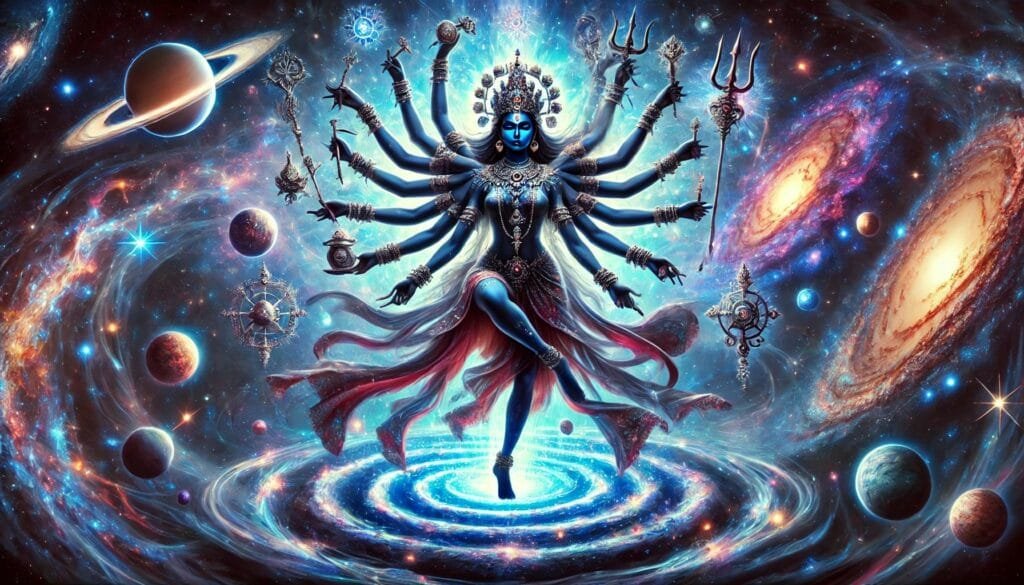Goddess of transformation and liberation
The world's mythologies are full of archetypes that convey deeper truths about the human condition. In the Indian spiritual tradition, Kālī, the goddess of transformation and liberation, is one of the most powerful and complex symbols.
Kālī is depicted with dark, midnight black skin, symbolising absolute emptiness. The word 'emptiness' or 'śūnyatā' may at first seem negative or nihilistic, śūnyatā is not in fact nothingness, but the incomprehensible depth of the ultimate reality of existence.
In other words, emptiness is not nothingness, but the all-embracing totality from which everything is created and to which everything returns. Kālī's black body is the foundation of the universe, the infinite space that contains and never judges. This symbolism carries a profound spiritual message: death and destruction are not an end point, but a transformation that creates the possibility for something new to be born.
The "Heart Sutra" teaches that "form is emptiness, and emptiness is form." This statement sums up the central message of śūnyatā: things as we perceive them do not have an independent, substantial being. Phenomena, though they appear to be real, do not have a constant, unchanging essence. Śūnyatā does not claim that nothing exists, but that everything is impermanent, in a constant flux, and that everything is merely the result of interdependent factors. Emptiness, therefore, does not mean absence, but Kālī's original naked state in which no form manifests.
Śūnyatā is the key to spiritual development, as it helps to break down illusions created by the human mind. The ego, which seeks permanence and control in the world, clings to the illusion of the permanence of phenomena. However, understanding Śūnyatā shows that nothing is permanent and that all our concepts of the world are the result of our individual experiences and preconceptions. When we realize that nothing is self-existent, we can let go of the bonds of possession, expectations and fears.
Emptiness does not mean that we give up on life, but that we live more fully because we are not bound by the illusion of permanence.
The nakedness of Kālī does not emphasize the display of the physical body, but refers to the nakedness of spiritual truth. His figure completely strips the world of illusion (māyā) and reveals the ultimate reality. His nakedness symbolizes that Kālī is one who is free from all forms and bondage and embodies the emptiness of pure existence.
The dark skin of Kālī is also related to the concept of śūnyatā. The darkness is not the absence of light, but a symbol of the all-encompassing space in which all that exists appears and disappears. This universal void is the source from which everything arises and to which everything returns. The darkness of Kālī is the aspect of consciousness that is beyond duality, where there is no good or bad, only pure existence.
Beyond this, darkness is the unknown, the reality not yet understood by the mind. Kālī's dark skin is also a reminder of the challenges of the spiritual path and the need for deeper self-knowledge. His presence encourages us to dare to enter our own shadows and discover the truth there.
This emptiness is not a lack, but the basis of existence. The naked goddess is a reminder that all forms are impermanent and conditional, and behind them lies śūnyatā, the all-embracing dynamism. This state is not static, but constant movement and change, manifested in the pulsation of life.
The wild dance of Kālī, often referred to as the dance of death (tāṇḍava), symbolises the constant movement and change of the universe. This dance is not destructive but transformative: it destroys the old to make room for the new. This dynamism is closely related to the concept of śūnyatā, which is also based on an understanding of constant change and the illusory nature of forms.
The dance of Kālī also symbolizes the experience of the spiritual path. In the constant flow of life, everything we try to grasp or possess is gone. The dance of the goddess teaches us not to cling to impermanent forms, but to let go of them and accept the changes of life.
The free, wild dance of the goddess - often depicted as the dance of death (tāṇḍava) - symbolises the movement of cosmic order. This energy burns away all form, illusion and bondage to make room for pure, true reality. Her dance is not chaos, but a symbol of the harmonious transformation of the universe.

